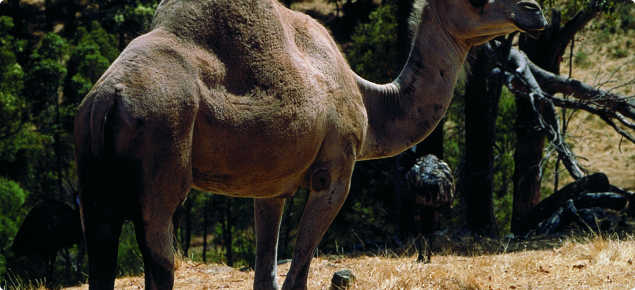Introduction
Camels which have reverted to the wild state are said to be feral. The first feral camels in Western Australia were those lost or stolen from early explorers. Additional releases of domestic camels into the wild occurred when the motor vehicle became commonplace in outlying areas in the 1920s and 1930s.
Feral camels are declared pests of agriculture in WA under the provisions of the Biosecurity and Agriculture Management Act 2007.
There are probably at least 300 000 feral camels in Australia; the only substantial feral camel population in the world. The size of the population in the Northern Territory is thought to have doubled between 1990 and 2000.
Distribution
Feral camels are spread throughout central Australia. They are generally confined to the deserts, being only occasionally seen on sheep and cattle stations in Western Australia.
Biology
Camels are highly mobile, even when feed is abundant they may forage over 70km per day. Studies in the Northern Territory indicate that females (cows) live together in groups that are temporarily herded by a male (bull). Bulls usually live in bachelor groups or alone. Group size depends on rainfall; in very bad years groups are small in size, while in good years, larger groups are observed.
Camels may go for long periods without drinking, however in summer they will drink every day if water is available. They tend to spend the night on areas of bare ground away from the waterhole, watering at first light and then moving off.
They are remarkably well adapted to their desert environment. Their coat acts as an insulating layer in winter and reflects radiant heat in summer. They have a tough skin able to withstand thorns and spinifex, and a padded foot adapted for movement on sand and gibber plains as well as insulating the animals from the hot earth. They have hard pads on the brisket, knees and elbows to protect them when they kneel.
Camels conserve water by reduced sweating and they also concentrate their urine like most desert mammals. Their body temperature rises nearly 3°C before they start to sweat. It may fall by 6°C at night. They can lose much of their body water without ill effects and rapidly return to normal when they are again able to drink. Camels have exceptionally good eyesight and sense of smell.
Identification
The Arabian camel, which is the only species found feral in Australia, is a large animal weighing between 450-650kg. It is grey brown or dun coloured with a darker hump, shoulder and back of the neck. The winter coat, which is shed in early summer, is longer and darker than the summer coat.
Food habits
The single hump makes up to 20% of the body weight. It consists of connective tissue and stored fat. The shape and size of the hump is indicative of the animal's condition. The preferred diet of camels is succulent herbage, high in water and, often, salt content. Grasses make up between 20-40% of the diet (70-90% in cattle). Camels also eat the fruit, leaves and stems of many shrubs and will badly damage some native trees such as the Quandong or Native Peach (Santalum acuminatum). Their long legs and neck enable them to browse trees much further from the ground than any other terrestrial herbivore in Australia.
Reproduction
Camels live for up to 50 years and may actively breed for 30 years. Females come on heat several times a year. Gestation lasts about 13 months; calves are born on average once every two years. Twins are rare. Males come into season from one to three times a year, each time for several weeks. They develop large patches of sticky smelly excretion on the backs of their heads when in season and are also particularly intractable at this time.
Damage
The main problem caused by feral camels is destruction of fences. Camels pass through fences by leaning on them until they collapse, and will often demolish long lines of fence for no apparent reason.
They may also foul or damage water points, especially in drought. They behave aggressively towards sheep and cattle, sometimes depriving them of feed or water. However, in WA camels are rarely present in stocked country in sufficient numbers to create a major problem.
Camels are susceptible to a number of diseases such as tuberculosis and brucellosis - serious diseases of livestock. Attempts to eradicate these diseases must take into account the possibility of a disease reservoir remaining in the feral camel population.
Although less destructive than many other introduced herbivores, camels can cause environmental damage, particularly to some arid zone plants.
Declared pest category
The Western Australian Organism List (WAOL) contains information on the area(s) in which this pest is declared and the control and keeping categories to which it has been assigned in Western Australia (WA). Use the links on this page to reach feral camel in WAOL.
Further information
For further information contact the Pest and Disease Information Service.


